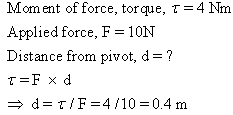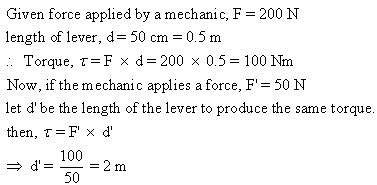Class 10 FRANK Solutions Physics Chapter 1.1 - Turning Effect of Force and Equilibrium
Use Frank Solutions for ICSE Class 10 Physics Chapter 1.1 Turning Effect of Force and Equilibrium to revise key chapter concepts. Learn to define moment of force or explain what’s meant by equilibrium of a body. Refer to our textbook solutions to revise Physics concepts such as couple, moment of couple, rotatory motion, translational motion etc.
Practise TopperLearning’s Frank Solutions for ICSE Class 10 Physics to grasp the turning effect of force and equilibrium. Score better in your Physics exam by benefitting from our chapter resources such as concept videos, question papers, online tests and more.
Turning Effect of Force and Equilibrium Exercise 13
Solution 1
Moment of a force = Force x perpendicular distance of the pivot from the force.
Its SI unit is newton-metre (Nm).
Solution 2
Solution 3
Solution 4
e.g. the motion of a bullet fired from a gun, a ball thrown straight up and falling back straight down.
Solution 5
e.g. Earth's rotation about its axis, wheels of car in motion.
Solution 6
Solution 7
1. The magnitude of force applied.
2. The distance of the line of action of the force from the axis of rotation.
Solution 8
If the turning effect on the body is anticlockwise, moment of force is called the anticlockwise moment and is taken as positive.
Solution 9
(ii) If a rigid body moves around a center or is pivoted at a point, the applied force will cause rotational motion.
Solution 10
Solution 11
Solution 12
Equilibrium is a state of zero acceleration.
Solution 13
(a) The sum of the (vector) forces must equal zero, i.e. ? F = 0
(b) The sum of the torques must equal zero; i.e. ? ? = 0.
(ii) The conditions for dynamic equilibrium are:
(a) The body should have a broad base.
(b) Centre of gravity of the body should be as low as possible.
(c) Vertical line drawn from the centre of gravity should fall within the base of the support.
Examples:
Static equilibrium: a box at rest on a floor; there is a gravitational force pulling the object to the earth, but there is also an equal and opposite force applied by the floor to the box (pushing up).
Dynamic equilibrium: A rock travelling across the cosmos, far enough away from any other object (so as not to be affected by gravity - in other words, in zero gravity conditions); the rock continues to travel in a straight line at uniform velocity either for eternity, or until acted upon by an external unbalanced force.
Solution 14
(a) Vector sum of forces acting on the body should be zero.
(b) Algebraic sum of moments acting on the body should be zero.
Solution 15
Solution 16
Solution 17
(i) Opening and closing the cap of a bottle
(ii) Turning a key in a lock
Solution 18
(ii) Force 'P' has the maximum moment about 'O' because its perpendicular distance is maximum from 'O'.
Turning Effect of Force and Equilibrium Exercise 14
Solution 19
Effect of couple: It produces angular acceleration.
Solution 20
Its SI unit is Nm.
Solution 21

Solution 22

Solution 23

Solution 24
Conditions of equilibrium for a rigid body:
1. The body should have a broad base.
2. Center of gravity of the body should be as low as possible.
3. Vertical line drawn from the center of gravity should fall within the base of
support.
4. Vector sum of forces acting on the body should be zero.
5. Algebraic sum of moments acting on the body should be zero.

